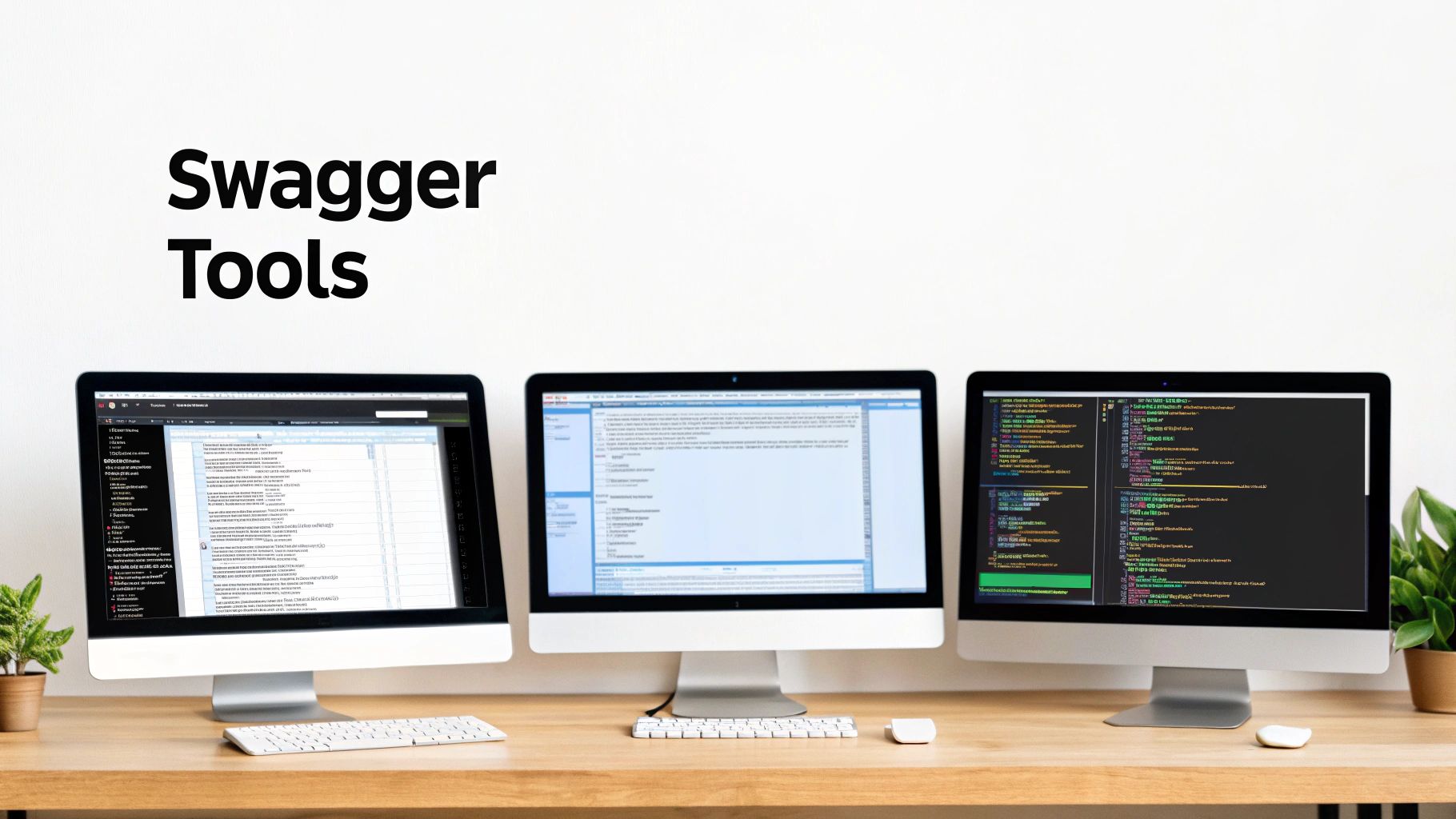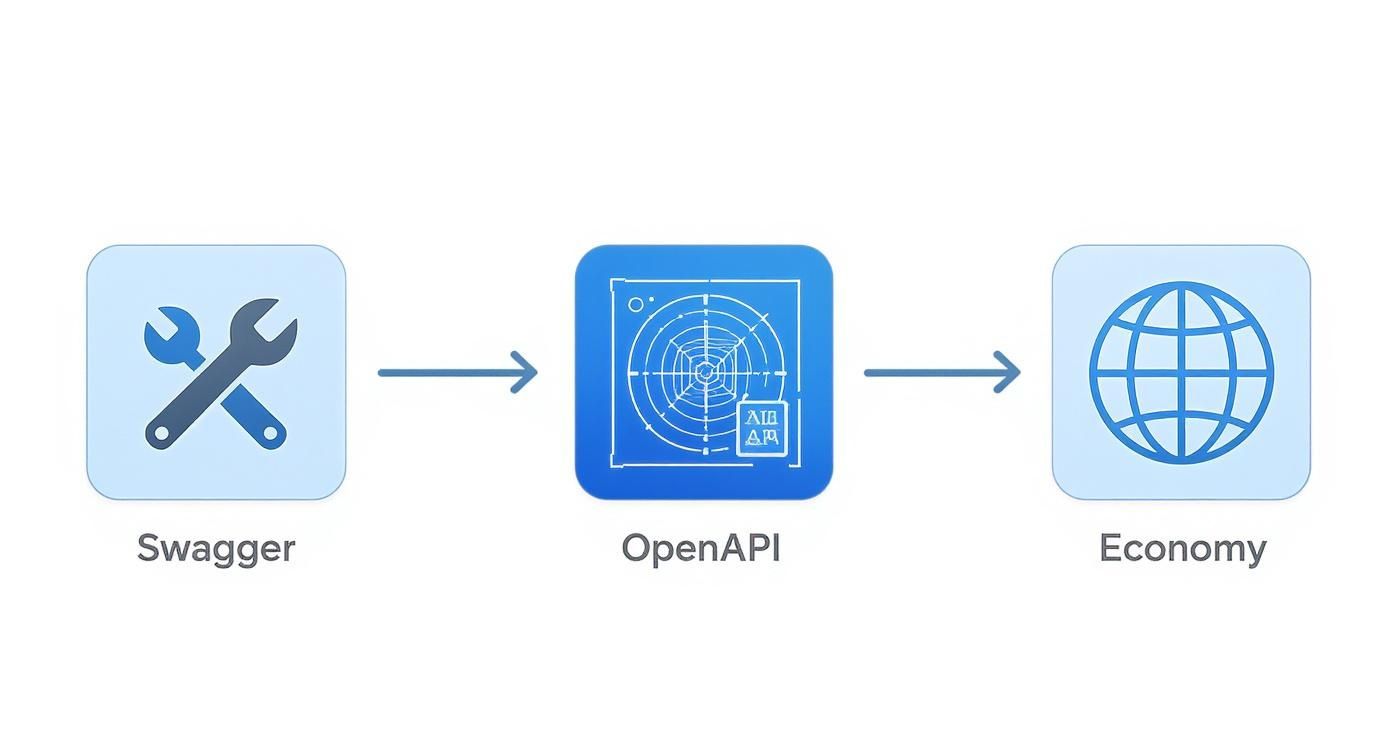what is swagger api: A Quick Guide to Swagger & OpenAPI
Ever tried to put together flat-pack furniture without the instructions? It’s a nightmare of confusion and guesswork. That’s pretty much what it’s like for a developer trying to use an API that has bad documentation.
Simply put, Swagger is the toolset that creates that missing instruction manual for your API. It makes it crystal clear for both people and computers how to talk to your API and what to expect in return.
What Exactly Is Swagger and Why Does It Matter?
Think of an API as a restaurant kitchen sending out food (data). In this analogy, Swagger is the menu. It’s a suite of open-source tools built around the OpenAPI Specification, which is the industry's go-to blueprint for designing RESTful APIs.
This is a key distinction to get right: OpenAPI is the standard, the set of rules. Swagger is the collection of tools you use to work with that standard—to design, build, and document your API. It brings a shared language and a ton of clarity to the whole development process.
Before we get too deep into what Swagger can do, it’s worth making sure you have a good handle on RESTful API principles. Swagger was built to describe these, after all. If you need a refresher, this guide on REST interview questions and answers is a great resource.
The Core Purpose of Swagger
At its core, Swagger was created to solve a massive communication headache. It bridges the gap between the different systems and the developers building them. By creating a standardized, machine-readable contract for an API, it cuts out the guesswork that so often leads to integration errors.
This contract lays out everything you need to know:
- Available Endpoints: What are the specific URLs you can interact with?
- Operations: What actions can you perform (like GET, POST, or DELETE)?
- Parameters: What information does the API need from you to fulfill a request?
- Responses: What data should you expect back, including potential error codes?
The image from the official Swagger website below gives you a glimpse into its ecosystem of tools.

This really highlights how the different tools work together to cover the entire API lifecycle. Its popularity is no accident; with a 28% usage rate among developers globally, Swagger is one of the most trusted names in the game. That kind of adoption speaks volumes about its value in building reliable APIs. Of course, a great tool is only as good as how you use it, which is why following API documentation best practices is so important.
The Swagger Ecosystem at a Glance
To make sense of it all, here’s a quick breakdown of the main tools in the Swagger family and what they do.
| Tool | Primary Function | Key Benefit |
|---|---|---|
| Swagger Editor | Lets you write OpenAPI specifications in a web-based editor. | Provides real-time feedback and validation to catch errors as you type. |
| Swagger UI | Renders OpenAPI specs as interactive API documentation. | Allows developers to test API calls directly in the browser. |
| Swagger Codegen | Generates server stubs and client SDKs from an OpenAPI spec. | Drastically speeds up development by creating boilerplate code for you. |
These three tools form the foundation of the Swagger experience, helping teams move from an idea to a fully documented and testable API much more efficiently.
Exploring the Core Swagger Toolset
The Swagger ecosystem isn't just one thing; it's a family of three powerful, interconnected tools. They work together to take you all the way from designing an API to helping others use it. Think of them as a well-oiled machine for building, documenting, and sharing APIs.

While this trio works in harmony, each piece plays its own vital part. Getting to know them is the best way to understand why Swagger has become such a staple in API development.
Swagger UI: The Interactive Documentation
First up, you have Swagger UI, which is probably the part of Swagger you've seen most often. It takes an OpenAPI specification file—which is usually a dense wall of YAML or JSON—and magically turns it into a clean, interactive, and genuinely human-friendly website.
But this isn't just a static help document. Developers can browse every available endpoint, see what parameters are needed, and—this is the best part—make live API calls right from the browser. This ability to poke and prod the API directly is a massive time-saver for learning and debugging, letting teams test out functionality without writing a single line of code.
By turning a technical blueprint into a live, testable interface, Swagger UI makes API exploration feel intuitive. It’s the ultimate "try before you buy" for any API.
Swagger Editor: The Live Design Environment
Next in the lineup is Swagger Editor. This is where a good API design often begins. It's a browser-based editor where you write your OpenAPI specification from scratch. As you type, the editor gives you instant feedback, flagging syntax errors and making sure your document is perfectly structured.
This live validation is a game-changer. It catches common mistakes early and enforces consistency right from the start. Better yet, the editor shows you a live preview of the Swagger UI documentation as you build it, so you know exactly how the final product will look and feel. It’s the perfect companion for an API-first design workflow.
Swagger Codegen: The Automation Engine
Finally, Swagger Codegen is the workhorse that does the heavy lifting. Once you've finalized your OpenAPI specification, this powerful engine can automatically generate server stubs and client SDKs in over 40 different programming languages.
This level of automation saves countless hours of writing boring, error-prone boilerplate code. For example, you can generate a mock server from your spec, which is a fantastic way to get development teams working in parallel. Our quickstart guide shows how tools like dotMock use OpenAPI files for instant API mocking. This lets your front-end team build against a stable API contract while the back-end team is still deep in development, decoupling the workflows and shipping faster.
Why Modern API Workflows Depend on Swagger
Bringing Swagger and the OpenAPI Specification into your workflow isn't just about adding another tool—it fundamentally changes how your team builds software. It stops being a simple documentation utility and becomes the central contract for your API.
Think of it as the single source of truth that gets everyone, from backend engineers to QA testers, on the same page. This "contract-first" approach is a game-changer. It puts an end to the classic back-and-forth arguments between frontend and backend teams over how an API is supposed to work.
With the API's structure clearly defined from day one, there's zero ambiguity about how data should be sent or what to expect in return. This clarity slashes integration bugs, which are often the most painful and time-consuming problems to fix. A well-defined contract, like these REST API specifications, is the foundation of a smooth development process.
Enabling True Parallel Development
Perhaps the biggest win here is achieving true parallel development. Once you have a stable OpenAPI document, the frontend team no longer has to sit around waiting for the backend to be built. They can spin up a mock server directly from that specification and start building the user interface right away.
An OpenAPI specification acts as a universal translator. It ensures that every team is speaking the same language, allowing them to build their respective parts of the application simultaneously with confidence.
By decoupling the frontend and backend workflows, you can shrink your development timeline dramatically. One team can focus on the API's business logic while another builds the client that will use it, confident that both pieces will plug together perfectly when ready. This is how modern teams ship products faster.
The Impact on Development Efficiency
The difference between building an API with and without Swagger is night and day. Without it, you're often stuck with manual documentation that goes stale the moment a change is made, leading to endless confusion and errors.
With Swagger, the interactive documentation is generated automatically, ensuring what developers see is always what they get. This simple shift has a massive impact across the entire development lifecycle.
Here's a quick breakdown of how things change:
API Development With vs Without Swagger
The table below shows just how much friction Swagger removes from common development phases.
| Development Phase | Without Swagger | With Swagger |
|---|---|---|
| Team Alignment | Disconnected; frequent sync meetings required. | Aligned around a single source of truth. |
| Integration | High error rate; painful debugging sessions. | Smooth integration; fewer "it works on my machine" issues. |
| Onboarding | Slow; requires manual guidance from senior devs. | Fast; new developers can self-serve with interactive docs. |
In short, Swagger transforms a potentially chaotic process into a predictable and efficient one. It helps teams collaborate better, integrate their work with fewer headaches, and get new members up to speed in record time.
Swagger's Role in the Global API Economy
To really get what Swagger API tools do, it helps to take a step back and look at the bigger picture. Swagger, and the OpenAPI Specification it's built on, aren't just handy tools for developers. They are, in many ways, the universal language driving the modern digital economy.
Think of it like this: the OpenAPI Specification is the "shipping container" of the digital world. Because every port, ship, and truck agrees on the exact size and shape of a shipping container, global trade just works. In the same way, OpenAPI creates a standard format that lets applications built by different companies, using completely different tech stacks, talk to each other without a hitch. This is the magic that powers everything from your banking app to global e-commerce.
This universal standard has created a colossal market. The global API economy is on track to hit $269.9 billion by 2025, which shows just how vital these digital connections have become for business. You can get a closer look at the numbers and learn more about these API economy findings.
Powering Entire Digital Ecosystems
When everyone speaks the same API language, businesses can build incredibly powerful and complex digital ecosystems. Suddenly, what was once a massive integration headache becomes a simple plug-and-play process.
We see this playing out everywhere:
- Open Banking: Banks can securely open up their services through standardized APIs. This allows fintech startups to build new, innovative apps on top of the bank's existing infrastructure.
- E-commerce: An online store's website might be talking to dozens of different APIs at once—one for credit card processing, another for shipping rates, and a third for inventory. They all work together seamlessly because they follow a common standard.
- Healthcare: Imagine hospitals, labs, and insurance providers being able to share patient data securely and instantly. That's made possible by APIs that adhere to a shared, industry-wide specification.
By offering a predictable, machine-readable contract for how software should interact, the OpenAPI Specification clears away the friction that used to slow down innovation. It’s the secret sauce that makes these vast, interconnected services a reality.
At the end of the day, getting good with Swagger is about more than just learning a new tool. It’s about understanding the fundamental grammar of modern business and learning how to build bridges between systems to create new opportunities in a connected world.
How to Use Swagger in Your Projects
Alright, enough with the theory. Let's get our hands dirty and see how you can actually put Swagger to work on a real project. This is where it goes from being a neat idea to an indispensable part of your development workflow.
One of the most effective ways to integrate Swagger is to adopt an "API-first" approach. Forget about writing code and then figuring out the documentation later. Instead, you start by firing up the Swagger Editor and designing the entire REST API contract before anyone writes a single line of backend logic. This design-first blueprint becomes the source of truth for the entire team.
From Design to Documentation and Code
If you already have an API but no documentation, Swagger can give you a massive quick win. Just create an OpenAPI specification for your existing endpoints, and Swagger UI will instantly spin up beautiful, interactive docs. This gives other developers a live sandbox to try out API calls, which absolutely slashes their learning curve.
But it doesn't stop there. With Swagger Codegen, you can automatically generate client libraries. Say your mobile team needs to integrate with a new API. Instead of them manually writing all the networking boilerplate, Codegen can spit out a complete client SDK in whatever language they need. That’s a huge time-saver.
Unlocking Parallel Work with Mocking
This is where things get really interesting: API mocking. Your OpenAPI file is more than just a document; it's a functional blueprint you can use to create a mock server. This is the secret to getting your teams working in parallel.
The infographic below shows how the OpenAPI spec and the tools around it act as the engine for the modern API economy.

As you can see, the blueprint created by these tools is what makes all of these seamless digital connections possible.
With a mock server running, your front-end team doesn't have to wait for the backend to be built. They can start developing and testing their user interfaces immediately, knowing they're building against a stable and accurate API contract. This completely decouples your development streams.
Tools like dotMock are built for this exact purpose. You can simply import an OpenAPI file and have a fully functional mock server up and running in moments, radically shortening your time to market.
Got Questions About Swagger and OpenAPI?
Even after you get the hang of the basics, a few common questions always seem to surface. They're the kind of "what's the real difference" and "can I use it for my project" questions that pop up on team chats and forums. Let's clear the air and tackle them head-on.
We'll sort out the whole Swagger vs. OpenAPI naming thing, figure out which APIs it's actually built for, and map out a simple way for you to get your hands dirty.
What Is the Difference Between Swagger and OpenAPI?
This is, without a doubt, the number one point of confusion. Here’s the simplest way to think about it: OpenAPI is the recipe, and Swagger is a famous set of kitchen tools for working with that recipe. They aren't the same, but they're made for each other.
Originally, the specification itself was called Swagger. But back in 2015, it was moved under the Linux Foundation's umbrella and renamed the OpenAPI Specification (OAS). This was a big deal because it ensured the spec would remain an open, vendor-neutral standard for everyone.
So today, the breakdown is pretty straightforward:
- OpenAPI is the specification itself. It’s the formal set of rules that dictates how you describe your API in a language computers can understand.
- Swagger is the family of popular tools from SmartBear that bring that specification to life. This includes things like the well-known Swagger UI, Swagger Editor, and Swagger Codegen.
Is Swagger Only for REST APIs?
For the most part, yes. Swagger and OpenAPI have become the go-to standard for describing REST APIs. The specification is designed around the building blocks of the web—HTTP methods (GET, POST, PUT, DELETE), URL paths, and status codes. This covers nearly all RESTful APIs and even many web APIs that aren't strictly REST.
The OpenAPI Specification is the gold standard for HTTP APIs, but it is not a universal solution for every API architecture.
However, it's not the right tool for every job. If you're working with other API styles, you'll need different tools. For example, GraphQL relies on its own Schema Definition Language, and protocols like gRPC use an entirely different framework for defining services. So, while OpenAPI dominates the HTTP world, it isn't a one-size-fits-all solution.
How Do I Get Started with Swagger?
Jumping in is easier than you probably think. A fantastic starting point is the free, web-based Swagger Editor. You can just start describing one of your existing APIs using either YAML or JSON. The editor gives you real-time feedback and validation, which is a great way to learn the syntax as you go.
If you're starting a new project, I'd strongly recommend an "API-first" approach. This just means you design the API contract in an OpenAPI document before you write any code. Once your spec is ready, you can instantly see it in action with Swagger UI or even use Swagger Codegen to automatically generate boilerplate server and client code. It’s a huge time-saver.
Tired of waiting on backend teams to finish their work? With dotMock, you can import your OpenAPI specification and get a fully functional, production-ready mock API in seconds. Test every scenario, from success cases to network failures, and get your development cycle moving faster. Create your free mock API at dotmock.com and start shipping features today.